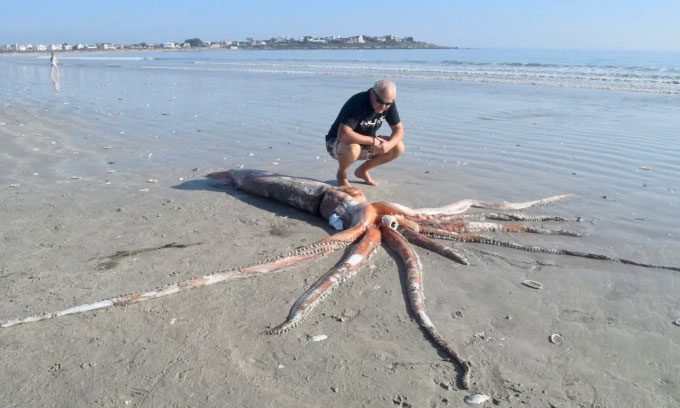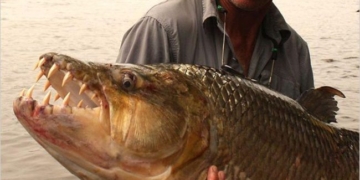With their massive size, short lifespan, and ability to live at depths of up to 1,000 meters, keeping giant squids in captivity is nearly impossible.
Many animal lovers want to observe these creatures up close, but in many situations, this is impractical, unfeasible, or unethical. Zoos and aquariums can play a crucial role in preserving vulnerable species in the wild, but some species cannot thrive in captivity. One such species is the giant squid.

The carcass of a giant squid washed up on Golden Mile beach in Britannia Bay, South Africa. (Photo: Adéle Grosse).
Giant squid (Architeuthis dux) are large deep-sea animals. They can grow as large as a bus, with eyes the size of plates. Despite their soft bodies, they possess a peculiar hard beak similar to that of a bird, used to slice through their prey.
The largest giant squid recorded by scientists was about 13 meters long and weighed nearly a ton, according to Smithsonian Ocean. The primary reason that these animals are unsuitable for life in aquariums is evident in their name: They are truly “giants.” Limited and cramped spaces can negatively impact many wild species, sometimes leading to zoochosis—captured animals performing repetitive behaviors.
Not to mention the ethical issues, recreating the giant squid’s natural habitat in an aquarium is also extremely difficult. The largest aquarium in the world is 125 meters wide and 11 meters deep, but giant squids usually inhabit depths of about 1,000 meters, far exceeding what an aquarium can offer.
Even if a sufficiently deep aquarium could be constructed, keeping giant squids would likely still fail because humans know very little about their lifestyle. For animals to thrive in an artificial environment, aquariums and zoos need to implement carefully regulated nutrition and care programs. To provide such programs, experts must first understand the giant squid.
Giant squids primarily hunt deep-sea fish and other squid species. According to the MarineBio Conservation Society, they hunt by using their tentacles to grab their prey and hold on tightly with serrated suckers. This is very challenging to establish in an artificial environment since it requires raising many living organisms from the deep sea.
Another obstacle is that it is very difficult to find live giant squids to introduce into an aquarium. Most images captured of giant squids are of them after they have died. Furthermore, even if a giant squid is successfully captured, it may not survive long in carefully designed tanks due to its short lifespan.
Giant squids have a short lifespan, with most species living only about 1 to 3 years. Scientists are not precisely sure of the lifespan of giant squids, but they believe they live no more than 5 years and only breed once, according to Smithsonian Ocean.


















































